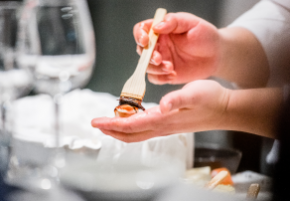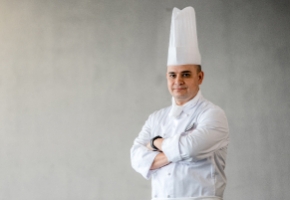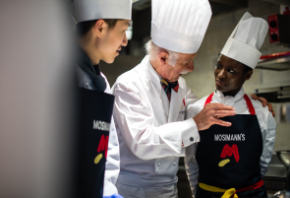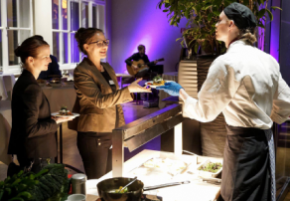- About
- Programs
- Campus Life
- Career Services
- Admissions
- News & Events
- Alumni
The Art of Plating Food: Techniques for Stunning Visuals
Discover plating food techniques that make your dishes stand out. Learn how to use color, height, and texture for professional and beautiful presentations.
Key Takeaways
- Plating is the process of arranging food to create an appealing visual experience before the first bite.
- Main techniques for plating food include using height and layers, balancing color and texture, creating clean sauce designs, and leaving intentional white space.
- Useful tools for plating food include plating tweezers, squeeze bottles, ring molds, brushes, and offset spatulas.
“The camera eats first” has become a popular trend, with many diners pausing to snap the perfect photo before their first bite. This habit highlights the growing role of presentation in the dining experience.
The saying “we eat with our eyes” continues to hold true, as plating has become an important aspect of how chefs and home cooks create dishes that are delicious, visually striking, and memorable.
Plating Techniques for Stunning Food Presentation
You may be able to put together the most delicious dish with perfectly balanced flavors, but if it doesn't look appealing on the plate, many people will hesitate to try it or simply won't feel as impressed.
Presentation is what sets expectations and gives people a sense of what they're about to experience before they even take that first bite. For an aspiring chef, understanding how to plate food is an absolute necessity.
To ensure your dishes look as stunning as they taste, consider these techniques:
The rule of three
The rule of three is a widely used principle in design, photography, writing, and public speaking, where groups of three elements create a sense of balance and visual appeal. The same idea applies to plating, keeping presentations visually balanced and not overwhelming.
According to this rule, placing components in odd numbers—typically three—is better than doing so in even numbers, as it can look too rigid or symmetrical.
By focusing on three main components, such as a protein, a vegetable, and a starch, you can create a well-balanced and structured plate.
Height and layers
Similar to how interior designers use different levels, shelves, and raised surfaces to make a room feel more dynamic and interesting, you can do the same for your plate, too.
Start with a solid base of starch or sauce as the first layer and then carefully build upward by stacking proteins and vegetables to add depth and structure.
You can also use ring molds or stackable elements to help create a clean, structured presentation. Height adds a sense of complexity and craftsmanship—whether it's a neatly layered lasagna slice standing tall or a carefully stacked tower of roasted vegetables and fish, the results feel more refined.
The center of the plate
While placing everything right in the center used to be the norm, modern plating techniques use the center as an anchor point with slight asymmetry. To apply this technique, start by placing the main item (like a piece of seared fish or meat) just off-center and build around it with small accents.
This approach will help guide the diner's gaze naturally around the dish. Placing everything dead-center can feel static, but using the center as a starting point with purposeful positioning keeps the presentation balanced yet artistic.
The use of white space
The empty areas of the plate are just as important as the food itself. Avoid overcrowding; let each component have breathing room so the dish feels clean and the plating intentional.
Begin plating by placing larger items first, then adding smaller details without cluttering. The remaining white space should allow each element to stand out. An example of this technique is the classic plating of a slice of cheesecake with a small cluster of berries on top and a light drizzle of sauce on the side—nothing more.
Sauce swooshes and dots
Sauces are not just for flavor; they can also be part of the presentation.
To make swooshes, place a spoonful of sauce on the plate and drag the back of the spoon through it in one fluid motion. For dots, use squeeze bottles to create neat circles of sauce around or alongside the main item.
These techniques add sophistication and help balance the visual weight of a plate. Think of a seared duck breast with a bold red wine reduction swoosh or delicate dots of herb oil around a seafood dish.
Color and contrast
A visually appealing plate often features pops of color and contrast to draw attention. When planning a dish, consider incorporating vibrant vegetables, colorful purees, or bright garnishes to balance the more neutral tones of proteins or grains.
For example, pairing golden-brown roasted chicken with vibrant green beans and a bright orange carrot puree will make the dish look more inviting. Start by arranging neutral elements first, then add bold colors to bring the plate to life.
Garnishing microgreens
Garnishing with microgreens is a technique that adds both beauty and freshness to a finished dish. These tiny, delicate greens—often sprouted versions of herbs or vegetables—act like the final decorative touches.
A small sprinkle of microgreens on top of a seared steak, a creamy risotto, or even a dessert will provide a pop of color, a hint of texture, and a burst of fresh flavor that helps balance everything, add elegance, and make the dish feel complete without overpowering the main elements.
Texture contrast
Texture enhances both taste and presentation. A well-plated dish should have visual texture as well as real textural contrast in each bite.
To achieve this contrast, combine crunchy, smooth, and soft elements. For instance, a creamy panna cotta served with a crisp almond tuile and fresh berries is far more interesting than the panna cotta on its own.
As you plate, consider which textures might be missing and incorporate them where needed.
Geometric shapes
Using geometric shapes can also add a lot of structure and elegance to a plate. For this technique, you can slice vegetables into perfect rounds, use ring molds for starches, or pipe mashed potatoes into spirals.
Such shapes will help create order and sophistication. For example, a circular ring of couscous with grilled shrimp arranged in a half-moon shape around it looks far more polished than a loose pile.
Whenever you use this technique, start by shaping the starch or base component and then place proteins and garnishes around it in clean, deliberate lines or curves.
Rims and borders
The rim of the plate is another important detail to consider. Keep the rims and borders clean, free of smudges, drips, or stray crumbs. Before serving, gently wipe the rim with a damp cloth to ensure a neat presentation.
A clean rim frames the dish like a work of art and makes everything feel more refined. Even a simple dish of pasta looks elevated when the sauce stays within the plate's inner circle and the rim is spotless.
Different Plating Food Styles
There are many different plating food styles, and that's why two dishes can use similar techniques yet seem different in presentation. The way a dish is plated reflects the mood, cuisine, and dining experience the chef wants to convey.
Some of the most popular plating styles include:
- Minimalist style: Focuses on simplicity, with clean lines, few elements, and plenty of white space.
- Contemporary style: Bold and modern, often using geometric shapes, playful arrangements, and contrasting colors.
- Rustic style: Emphasizes warmth and comfort with generous portions, natural textures, and casual, unstructured placement.
- Traditional style: Classic and elegant, with balanced proportions, often symmetrical or following well-established presentation rules.
- Avant-garde style: Creative and experimental, often breaking conventions with unexpected shapes, ingredients, or presentation methods.
- Organic/natural style: Inspired by nature, using irregular shapes, earthy colors, edible flowers, and other natural elements.
- Family style: Large, shared portions designed for serving multiple people at the table.
- Deconstructed style: Familiar dishes presented in separate components, arranged artistically on the plate.
- Monochromatic style: Uses ingredients of similar tones and colors but plays with texture.
Inspiration from Top Chefs and Restaurants
Some of the most creative and revolutionary ideas regarding different techniques and food plating styles came from the world's top chefs and Michelin-starred restaurants.
For example, René Redzepi of Noma is known for his nature-inspired presentations, Grant Achatz at Alinea has become famous for theatrical presentations, and so on.
At Culinary Arts Academy Switzerland (CAAS), this same level of creativity and care is instilled in students from the very beginning. Our chef instructors teach techniques but also encourage individuality and imagination in presentations.
A perfect example of this guidance can be seen in the story of Yihan Ying, the winner of our Cook'N'Battle virtual culinary competition. Drawing inspiration from her Chinese heritage, Yihan's beautifully plated Winter Blossom neriki wagashi dish left the judges speechless.
Her skill and meticulous attention to detail were extraordinary—one of her crafted neriki flowers had sixteen petals, each practiced repeatedly to ensure perfect spacing and delicate pastel hues.
Yihan credits much of her success to her mentor at CAAS, Chef Yann, saying,
From mise-en-place and plating advice to teaching me about color contrast, he's been so helpful. He also assisted me with time management and keeping calm. These are tips that helped me today but will also be useful going forward.
Tools and Equipment for Perfect Plating
Having the right tools for plating is just as important as mastering the technique behind it.
Some of the tools that every chef can rely on when plating food are:
- Plating tweezers that allow you to place garnishes with accuracy and control.
- Squeeze bottles for adding precise dots, lines, and swooshes of sauce.
- Ring molds for stacking ingredients.
- Pastry brushes for brushing sauces or purees in sweeping strokes across the plate.
- Offset spatulas for lifting and placing delicate items onto the plate without damaging them.
- Zesters for adding fine citrus zest or chocolate shavings.
- Small ladles or sauce spoons for pouring controlled amounts of sauces with precision.
- Palette knives for spreading purees or positioning elements on the plate carefully.
The Secrets Behind Picture-Perfect Plates
Plating is the stage where everything comes together—the ingredients you choose, the techniques you master, and the story you want to tell with your dish. Learning how to connect all those elements with confidence is something we take seriously at CAAS.
Of course, plating can be challenging. Carlos, one of our students, shared how stressful the plating experience can get when multiple plates need to be presented at once. But as he discovered, those moments are where real growth happens. In his own words:
I consider the plating part the best experience compared to the other tasks because I learned how to work under pressure, manage the timing, plate many dishes simultaneously, and be more efficient at helping.
This ability to stay focused and efficient under pressure is a skill that benefits chefs far beyond the plating station. That's why, at CAAS, our culinary courses and programs—whether it's the BA in Culinary Arts, the more focused Swiss Diploma in Culinary Arts, or the specialized Certificate in Vegetarian Culinary Arts—are designed to help students master plating along with every other part of the culinary process.
We believe that education, much like plating, is all about balance, creativity, and knowing how to bring every element together beautifully.
Frequently Asked Questions
Why is food plating important?
Plating is important because it sets the first impression of a dish by offering a visual preview of the flavors and care that went into its preparation.
What are the 5 basic elements of plating?
The five basic elements of plating involve creating a visual framework, keeping the presentation simple, balancing colors and textures, ensuring proper portion sizes, and highlighting the key ingredients.
What's the best way to keep plates and food warm while plating?
The best way to keep plates and food warm while plating is by pre-warming the plates in a low-temperature oven or warming drawer and plating quickly.
Interested in becoming a world-class chef? Learn more about Culinary Arts Academy Switzerland. Download our brochure.



























